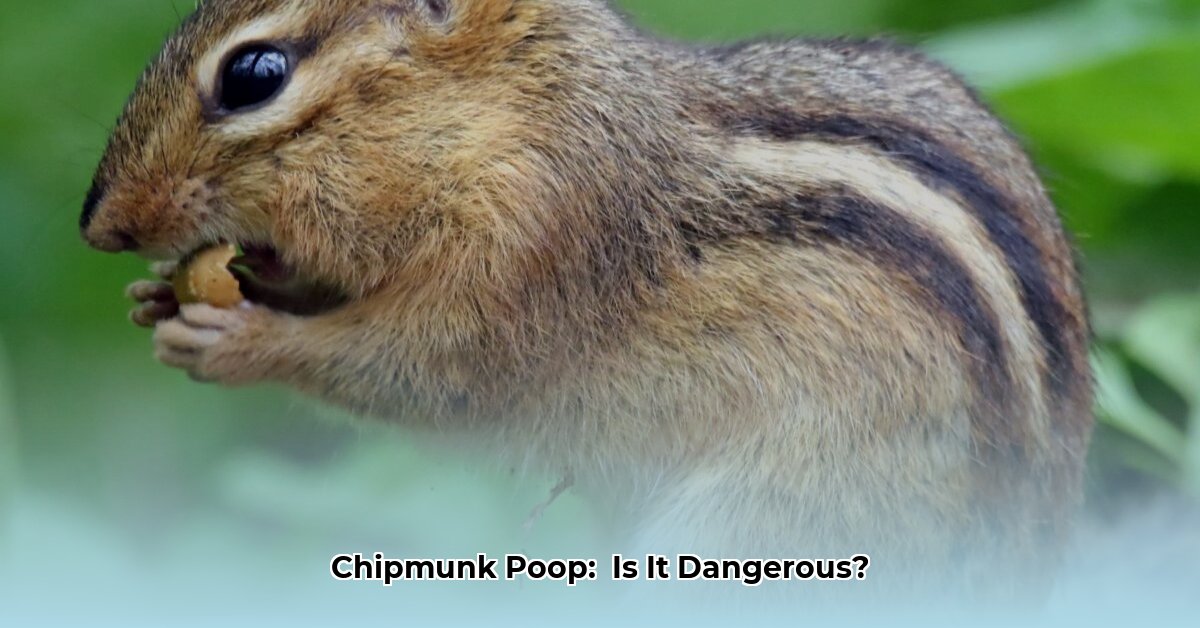Think you might have chipmunks? Droppings can be a key clue. This guide helps you identify chipmunk scat, understand the implications, and take action humanely.
Identifying Chipmunk Droppings
One of the first signs of a chipmunk presence is their droppings. These small, dark pellets can easily be mistaken for other rodent droppings, so proper identification is key.
What Do Chipmunk Droppings Look Like?
Chipmunk droppings resemble dark brown or black rice grains, roughly 3/8 of an inch long, often with slightly pointed ends. They’re smaller than rat droppings and larger than mouse droppings. Chipmunks tend to be relatively tidy, often depositing their droppings in concentrated areas, sometimes referred to as latrines, rather than scattering them randomly like mice. These latrines might be found near their burrows, feeding areas, or along well-worn trails within their territory.
Here’s a handy visual comparison:
| Dropping Type | Size | Shape | Color | Location |
|---|---|---|---|---|
| Chipmunk | About 3/8 inch (9mm) | Pellet-shaped, pointed ends | Dark brown/black | Localized latrines, often near burrows |
| Rat | About 3/4 inch (19mm) | Oblong, cylindrical | Dark brown/black | Scattered |
| Mouse | Smaller than rat | Rod-shaped, granular | Dark brown/black | Scattered |
A picture comparing the three types of droppings side-by-side would be extremely helpful here.
Dangers and Implications of Chipmunk Droppings
While chipmunks themselves are generally not aggressive towards humans, their droppings can pose potential health risks. Like other rodent droppings, chipmunk scat can carry bacteria and viruses, including:
- Salmonella: This bacteria can cause food poisoning, leading to diarrhea, vomiting, and fever.
- Leptospirosis: This bacterial disease can cause a range of symptoms, from mild flu-like illness to severe kidney and liver damage.
- Hantavirus (less common): While chipmunks are not the primary carriers, they can potentially transmit hantavirus, a serious respiratory illness.
The risk of contracting these diseases from chipmunk droppings may be relatively low, but precautions are still necessary. Airborne particles from dried droppings can also cause respiratory irritation. Additionally, finding droppings inside suggests chipmunks have access to your home, potentially leading to nesting and further contamination.
Cleaning Up Chipmunk Droppings
Cleaning chipmunk droppings requires care to minimize health risks. Follow these steps:
- Protect Yourself: Wear gloves, a mask (ideally an N95 respirator), and eye protection.
- Dampen the Droppings: Lightly mist the droppings with a disinfectant solution (one part bleach to ten parts water) or simply water to prevent airborne particles.
- Remove the Droppings: Use a disposable scoop, paper towels, or a stiff brush and dustpan. Avoid touching the droppings directly.
- Disinfect the Area: Thoroughly clean and disinfect the area with a bleach solution or an EPA-registered disinfectant.
- Dispose of Waste: Seal the droppings in a double-bagged plastic bag and dispose of it in your regular trash. If local regulations permit, incineration is also an option.
Humane Chipmunk Removal and Control
The most humane way to deal with a chipmunk problem is to prevent them from entering your home and encourage them to relocate elsewhere.
Humane Trapping and Relocation
Live traps, baited with nuts, seeds, or peanut butter, can be effective. Check traps frequently, and relocate captured chipmunks at least five miles away from your home, preferably in a suitable natural habitat. Always check local regulations regarding trapping and relocation. Be aware that relocating chipmunks during breeding season may separate young from their mothers.
Exclusion and Deterrents
- Seal Entry Points: Inspect your home’s exterior for cracks, gaps, and holes. Seal these potential entry points with caulk, steel wool, or hardware cloth.
- Trim Vegetation: Keep trees, shrubs, and other vegetation trimmed back from your house to eliminate easy access.
- Natural Deterrents: Some homeowners report success using natural deterrents like peppermint oil, garlic, or cayenne pepper sprinkled around potential entry points. Research on the effectiveness of these methods is ongoing, and results may vary.
- Commercial Repellents: Commercial repellents designed for squirrels may also deter chipmunks. Follow product instructions carefully.
Ongoing Prevention
- Secure Food Sources: Store pet food indoors, secure garbage cans, and use squirrel-resistant bird feeders.
- Eliminate Hiding Places: Remove woodpiles, debris, and other potential hiding spots near your home.
- Monitor for Activity: Regularly inspect your property for signs of chipmunk activity, such as fresh droppings or burrows.
Frequently Asked Questions (FAQs)
-
Do chipmunks nest indoors? While they prefer underground burrows, chipmunks may nest indoors, especially in attics, wall voids, or crawl spaces. Finding droppings inside is a strong indicator of a possible indoor nest.
-
When are chipmunks most active? Chipmunks are diurnal, meaning they are most active during the day.
-
Are chipmunks aggressive? Chipmunks are generally not aggressive towards humans, but they may bite if they feel threatened or cornered. Admire them from a safe distance.
-
What should I do if a chipmunk bites me? Wash the bite thoroughly with soap and water and seek medical advice. While rare, chipmunks can carry diseases.
Ongoing Research
Research on chipmunk behavior, the potential health risks associated with their droppings, and the most effective control methods is ongoing. Some experts suggest that environmental factors can influence disease prevalence in chipmunk populations. There is also ongoing research into the long-term effects of various repellent strategies. Consult with local wildlife professionals or your local health department for the most up-to-date information and specific guidelines for your area.
- Bento Tray Revolutionizes Organized Meal Transport and Presentation - December 10, 2025
- Meal Plans for Busy Schedules That Make Healthy Eating Easy - December 10, 2025
- Where to Buy Bento Boxes for Healthy, Organized Meals - December 9, 2025










